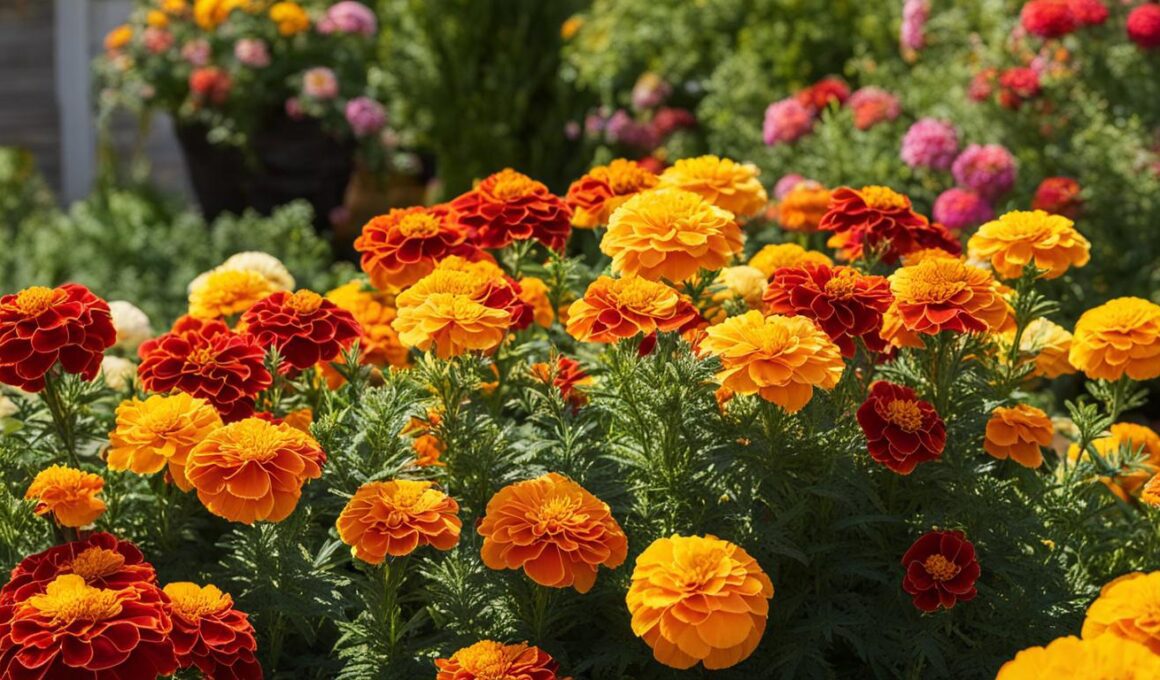Marigolds are a vibrant addition to any garden, boasting beautiful gold and copper blooms that last all summer long. But their appeal goes beyond aesthetics. These easy-to-grow annual flowers offer a plethora of benefits for your garden, from pest control to supporting the health of other plants. Let’s explore the wonders that marigolds can bring to your outdoor space.
Marigolds are not just pretty flowers; they are a powerhouse in the garden. Their ability to naturally repel pests like mosquitoes and cabbage moths makes them an excellent addition for those seeking organic pest control methods. Additionally, these versatile flowers act as companion plants, providing vital support for other garden plants while deterring harmful insects and nematodes.
Furthermore, marigolds can be an edible delight for both humans and pollinators. Their vibrant blooms attract bees and butterflies, aiding in the pollination of neighboring flowers and enhancing the biodiversity of your garden. As an added bonus, marigolds’ edible flowers can be used to elevate salads, teas, and other culinary creations.
Whether you have a green thumb or are a novice gardener, marigolds are an excellent choice. Their low maintenance nature and adaptability make them suitable for all skill levels. Native to the Americas, marigolds thrive in warm and dry conditions, making them a reliable addition to gardens across the United States.
Key Takeaways:
- Marigolds not only add aesthetic appeal to your garden but also offer various benefits.
- They act as natural pest control, repelling mosquitoes, cabbage moths, and other harmful insects.
- Marigolds are companion plants, supporting the health of neighboring plants and deterring nematodes.
- These vibrant flowers attract pollinators like bees and butterflies, enhancing the biodiversity of your garden.
- Marigolds are edible and can be used in culinary creations, adding a unique flavor and visual appeal.
Different Varieties of Marigolds for Your Garden
Marigolds are known for their vibrant gold and copper blooms, but did you know that there are different varieties of marigolds to choose from for your garden? Each variety has its own unique characteristics and growing requirements, allowing you to create a diverse and colorful display. Let’s take a closer look at the four common varieties of marigolds:
Tagetes Erecta
Tagetes erecta, also known as African marigold, is the tallest variety of marigold, reaching heights of up to 39 inches. It features large, fully double flowers in shades of yellow, gold, and orange. These marigolds are excellent for adding height and drama to your garden borders or as cut flowers in your arrangements.
Tagetes Patula
If you’re looking for a more compact marigold variety, Tagetes patula, or French marigold, is a great option. It grows to a height of about 24 inches and produces an abundance of smaller flowers in a wide range of colors, including red, orange, and bi-color combinations. French marigolds are perfect for edging flower beds, container gardening, or as companion plants in your vegetable garden.
Tagetes Tenuifolia
Tagetes tenuifolia, commonly known as signet marigold, is a delicate and compact variety with small, single flowers. It has finely cut foliage and emits a pleasant citrus scent when brushed against. This marigold variety is ideal for growing in pots, hanging baskets, or along the edges of pathways, adding a touch of fragrance and charm to your garden.
Calendula Officinalis
Calendula officinalis, also referred to as English or poet’s marigold, is a beloved variety known for its bright and bold blooms. Unlike other marigold varieties, Calendula officinalis is often grown for its medicinal properties and culinary uses. Its vibrant orange or yellow flowers are not only visually appealing but also make a lovely addition to salads, soups, and herbal teas.
By choosing different varieties of marigolds, you can create a visually stunning garden with a range of colors, heights, and scents. Consider the space available in your garden, your design preferences, and the growing conditions to select the marigold varieties that best suit your needs. Whether you opt for the towering beauty of Tagetes erecta or the compact charm of Tagetes tenuifolia, marigolds will surely bring joy and vibrancy to your outdoor space.
The Benefits of Marigold Companion Planting
Marigold companion planting offers several benefits for your garden. By strategically planting marigolds alongside other plants, you can enhance the overall health and productivity of your garden.
Attracting Pollinators
One of the key advantages of marigold companion planting is the ability to attract pollinators such as bees and butterflies. These insects play a crucial role in cross-pollination, which is essential for the reproduction and fruiting of many plants. By attracting pollinators to your garden, you can increase the yield of fruits and vegetables and encourage the growth of healthy, vibrant plants.
Pest Control
Marigolds also serve as natural pest control agents. The strong fragrance of marigold flowers repels many common garden pests, such as aphids, whiteflies, and nematodes. Additionally, marigolds act as trap crops, attracting harmful insects and diverting them away from other plants. This can help protect your garden from infestations and reduce the need for chemical pesticides.
Nematode Protection and Soil Fertility
Another benefit of marigold companion planting is their ability to reduce the population of harmful nematodes in the soil. Nematodes are microscopic worms that feed on the roots of plants, leading to stunted growth and poor health. Certain varieties of marigolds, such as Tagetes patula, release chemical compounds that repel nematodes, preventing them from damaging your crops. Additionally, marigolds improve soil fertility by adding organic matter and nutrients when they decompose. This can enhance the overall quality of your garden soil and support the growth of healthy plants.
| Benefits of Marigold Companion Planting |
|---|
| Attracting pollinators |
| Pest control |
| Nematode protection |
| Soil fertility improvement |
Marigold companion planting offers a natural and sustainable approach to promote a flourishing garden. By harnessing the benefits of marigolds, you can create a harmonious ecosystem and enjoy the rewards of a bountiful garden.
Growing and Caring for Marigolds in Your Garden
Marigolds are a popular choice for gardeners due to their vibrant blooms and numerous benefits. Whether you choose to start marigolds from seeds indoors or plant them directly outdoors, proper care is essential for their successful growth. Here’s a step-by-step guide on how to grow and care for marigolds in your garden.
Starting Seeds Indoors
If you prefer to start marigolds from seeds, you can begin the process indoors before transplanting them outdoors. Here are the steps:
- Fill seed trays or pots with a soilless potting mix.
- Sow the marigold seeds according to the instructions on the seed packet.
- Place the seed trays in a warm location that receives adequate sunlight.
- Keep the soil consistently moist, but avoid overwatering.
- Once the seedlings have grown a few inches tall and the threat of frost has passed, you can transplant them outdoors.
Planting Outdoors
When planting marigolds outdoors, consider the following:
- Wait until the last frost has passed and the soil has warmed up.
- Choose a sunny location with well-draining soil.
- Prepare the soil by loosening it and removing any weeds.
- Dig holes that are slightly larger than the root ball of the marigold seedlings.
- Place the seedlings in the holes and gently firm the soil around them.
- Water the plants thoroughly after planting.
Marigolds require regular watering, but it’s important to allow the soil to dry out between waterings to prevent root rot. Mulching around the plants can help retain moisture and limit weed growth. While deadheading is not necessary for marigolds, it can encourage continuous blooming throughout the season.
| Plant Care Tips | Additional Notes |
|---|---|
| Watering | Water regularly, allowing the soil to dry out between waterings. |
| Sunlight | Plant marigolds in a sunny location that receives at least 6 hours of direct sunlight per day. |
| Fertilizing | Marigolds don’t require heavy fertilization, but you can use a balanced plant food once or twice during the growing season. |
| Pest Control | Marigolds are relatively resistant to pests, but keep an eye out for aphids, caterpillars, and slugs. Use organic pest control methods if necessary. |
By following these care instructions, you can ensure healthy and thriving marigold plants in your garden. Enjoy the beauty of their vibrant blooms and reap the benefits they provide to your outdoor space.
– Will Planting Marigolds with Peppers Have Positive Effects on the Garden?
Yes, planting marigolds with peppers can have positive effects on the garden. Marigolds are natural pest repellents, helping to keep harmful insects away from your peppers. Additionally, their vibrant blooms can attract beneficial pollinators, which can improve the overall health and yield of your pepper plants.
Conclusion
Marigolds are versatile and beneficial plants for your garden. They not only add beauty to your outdoor space but also provide numerous benefits. By incorporating marigolds into your garden, you can enhance the overall aesthetics and health of your garden.
One of the significant advantages of marigolds is their ability to act as mosquito repellents. Their vibrant blooms not only attract pollinators like bees and butterflies but also repel harmful insects like slugs. As companion plants, marigolds release a chemical component that repels pests, keeping cabbage moths, white flies, and other insects at bay.
In addition to pest control, marigolds also improve soil fertility. They replenish lost nutrients and reduce the population of harmful nematodes in the soil. By incorporating marigolds into your garden, you can support the health and vitality of other plants.
Growing and caring for marigolds is relatively easy. Whether you choose to start them from seeds indoors or plant them directly outdoors, marigolds thrive in warm, dry conditions. They require well-draining soil, regular watering, and benefit from mulching to limit weed growth. With these gardening tips, you can ensure a successful garden and enjoy the benefits of marigolds year after year.
FAQ
What are the benefits of growing marigolds in a garden?
Marigolds add vibrant colors to your garden, attract pollinators, repel pests, and support the health of other plants.
What varieties of marigolds can I choose from?
There are four common varieties: Tagetes erecta, Tagetes patula, Tagetes tenuifolia, and Calendula officinalis.
How does marigold companion planting benefit my garden?
Marigolds attract pollinators, repel pests, reduce harmful nematodes, and improve soil fertility.
How do I grow and care for marigolds in my garden?
Marigolds can be started from seeds indoors or planted directly outdoors. They require well-draining soil and regular watering.
Are marigolds suitable for gardeners of all skill levels?
Yes, marigolds are easy to grow and maintain, making them a great choice for gardeners of all skill levels.












